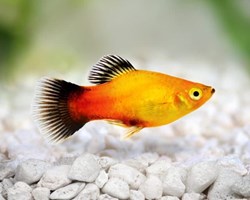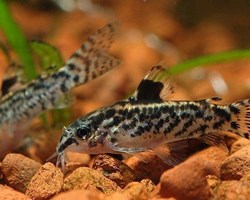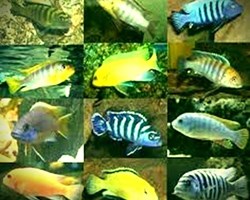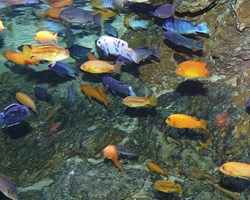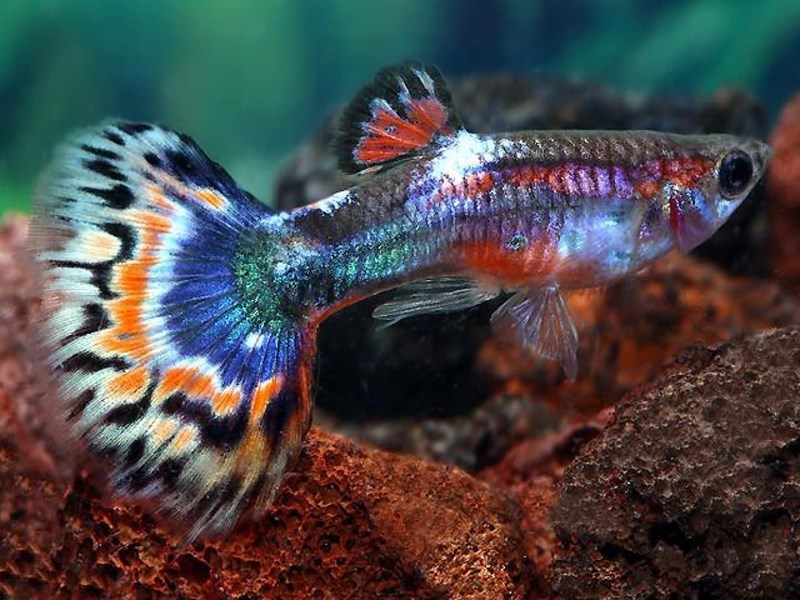
AT GLU GLU PET WE GIVE YOU THE BEST TIPS TO TAKE CARE OF YOUR GUPPY:
The guppy is not in danger of extinction, it is not a protected species.
Due to its high reproductive capacity and popularity, it is also called the million fish.
The guppy has a very wide distribution area.
It ranges from the northern Amazon through northeastern South America and the Lesser Antilles.
Guppies live on the margins of almost any body of water, including brackish water at the mouths of rivers.
They avoid deep water and prefer streams and riverbanks.
These diurnal fish usually swim between the intermediate zone and the surface of the body of water in which they are found.
Guppies are hardy and adapt well to their environment.
After several generations they can even withstand temperatures of up to 12 degrees.
Due to their robustness and to control mosquito infestations, guppies were kept wild in many parts of the world.
This was expected to reduce diseases caused by mosquitoes.
This beneficial effect is also used, for example, in hot springs.
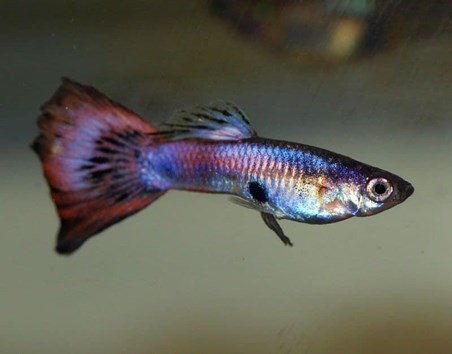
HOW IS A GUPPY FISH:
The guppy (Poecilia reticulata) also known as guppies or million fish, is one of the most popular freshwater fish species, and there are many reasons for its popularity.
The Guppy Fish belongs to the Poeciliidae family, which in turn falls within the Cyprinodontiformes group.
Among the freshwater aquarium fish they are probably the most popular, there are four basic reasons for their popularity:
They are very easy to care for fish, suitable for the most novice acuriophiles.
They have an attractive color palette, and a very striking and distinctive tail fin, which can vary from one specimen to another, but which always attracts attention due to its enormous beauty.
They are very resistant, they are able to withstand the most typical mistakes of novices.
They reproduce easily. Being able to reproduce fish inside the aquarium is always a great satisfaction.
There is a curiosity about these fish and their discovery, as with other animal and plant species, was "discovered" in different places, by different people who gave them different names.
Its scientific name (Poecilia reticulata) is due to its true discoverer, the zoologist Wilhelm Peters in 1859.
But its commercial name "Guppy", we owe to the naturalist John Lechmere Guppy.
Guppy's name is remembered because he did a great job with this fish, eradicating malaria.
But they are not the only names it bears, since in Trinidad it is known as "million fish" because of the ease with which it reproduces. In Argentina and Uruguay it is known as “lebistes”.
They are brightly colored fish and fun to watch (you can spend hours admiring the beauty of these little fish).
One thing that certainly sets them apart as a species is the fact that they are much easier to maintain than most other species.
The guppy, also called million fish, is a tropical water fish from Central America, with its easy reproduction and wide demand, it is a fish that has spread widely among aquarists around the world, having a large number of color patterns available .
The guppy is between three and five centimeters long.
Females are usually somewhat larger and rounder than males.
In captivity they can be up to five years old, while in the wild it is rare for them to exceed two years.
Guppies are viviparous.
Females are inconspicuous and have silvery-white, scaly skin.
The males are more striking, as they have long fins.
The caudal fin can end in a beak, a blade, a crown, etc.
The shape of these fins is what gives the name to each of the guppy varieties.
In addition to the different shapes, the tails of male guppies come in numerous shades.
Breeding species can be very striking, but they have little to do with female guppies in their natural habitat, where the males are brightly colored and there are several subspecies.
Common name: Guppies.
Scientific name:Poecilia reticulata .
Family: Poeciliidae.
Temperature: 22-28 ºC (optimal 26ºC).
Maximum size: 3.5 cm for males and 6 cm for females.
PH: 7.0 - 8.0 (optimal 7.3).
Kh: 14-18ºKh.
Gh: 12 - 20ºGh.
Diet: Omnivorous.
Temperament: Peaceful fish with other species, but care must be taken to keep 1 male for every 2-5 females so that they do not harass them excessively and cause them stress or any damage.
In 1866 a fish was caught in the waters off Trinidad and sent to the German researcher Albrecht Günther for classification.
Since then the system has remained unchanged. The 1859 find designations are no longer valid.
Guppies belong to the family of bony fishes and in this to the subfamily of poeciliids.
In the category of actinopterygian they belong to the subcategory of neopterygia.
There are numerous types of breeders of these fish that specialize in specific fin shapes and colors.
Most varieties of guppy fish differ in the shape of the caudal fin.
Also the color of this can vary depending on the breeding.
Breeders avoid crosses between different varieties, as the beautiful colors are often lost.
The Guppy is native to Central America, South America and the southern Caribbean.
It can be found in the wild in Venezuela, Guyana, Suriname, French Guiana, as well as the islands of Trinidad and Tobago, Barbados, Antigua and Barbuda, and the Netherlands Antilles.
In tropical areas it is used to fight against mosquitoes that transmit malaria, since they are great consumers of mosquito larvae.
WHERE TO FIND FREE GUPPY FISH:
Although this is its original distribution, the Guppies that we buy in stores are bred in captivity to be sold.
It is a fish highly appreciated by all those who start in fish farming, as it is very robust and easy to reproduce.
It can be found in a large number of places, where it adapts easily: streams, swamps, turbid areas, even brackish waters.
Among the long-finned guppies the following are distinguished:
- Double sword tail.
- Flag tail.
- fan tail
- Upper sword tail.
- Lower swordtail.
- Triangle tail.
- Lyre tail.
Small-finned guppies exist in the following varieties:
- Needle tail.
- Shovel tail.
- Pike tail.
- round tail
THE GUPPY ENDLER OR POECILIA WINGEI:
It has bright metallic colors, which may be due to its original habitat.
They have a multicolored coloration, with gray, gold or silver tones, which makes them very striking and desired in aquariums.
In terms of size, they are quite similar to normal Guppies. Its caudal fin is transparent, and quite normal compared to the most commercial Guppies.
Its appeal lies in its metallic color.
The guppy endler is a special variety.
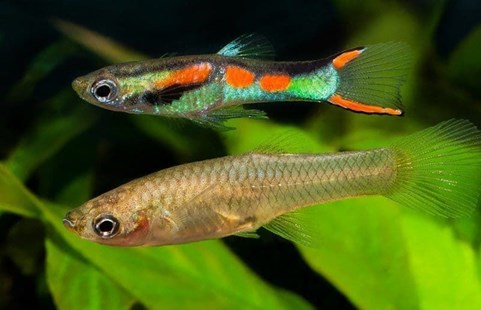
LEOPARD GUPPIES:
Leopard Guppies stand out for the coloration of their caudal fin.
The true leopard guppy is yellow, but there are colors that are just as showy, such as the male leopard guppy rose gold, semi black, mosaic green, diamond blue, yellow cobra... and a good number of equally striking colors.
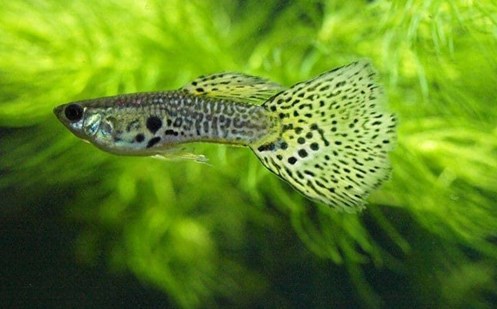
GUPPY CROWNTAIL:
It is a question of a variety of recent appearance, they are the Guppy tail of crown.
To get this new variety, it has been sought to generate mutations in its fins.
It is not yet a species admitted to exhibitions, because no guidelines have been established to guide it.
Within these Guppies, there are three subgenera, swallowtail, swallowtail, combtail, with tail similar to Betta, and merah.
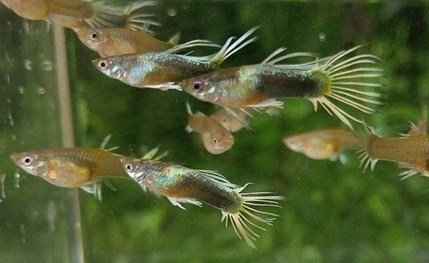
It is a fairly recent aquarium fish discovered in 1975 by researcher John A. Endler in Venezuela.
It differs from common guppies in complexion and color.
It was considered a subcategory, but in 2005 it was recognized as a single species.
It is characterized by a greenish color at the base of the tail and an orange band in front of it.
It is easy to maintain and loves a well-lit, plant-filled aquarium.
Guppies have an obvious and marked sexual dimorphism, so it is easy to distinguish male Guppies from female Guppies.
HOW MALE GUPPIES ARE:
Males are smaller compared to females, between 3 to 4 centimeters, and have a greater variety of colors.
Another differentiating characteristic is that they have a modification of the anal fin called gonopodium, which is their sexual organ, located on the back of the fish and has a shape similar to a stick.
The caudal fin of the male Guppy Fish is surprising for the large number of shapes it can have.
Due to the crossbreeding and genetic modifications to which it has been subjected over time, we can find male Guypps with pointed, rounded, crown-shaped, delta-shaped, double-sword-shaped fins and the most common and appreciated, the tail fin fan-shaped.
FEMALE GUPPY FISH:
In the Guppy fish, the females are larger, between 6 and 8 centimeters, bulky and dull in color.
In the species bred in captivity and selected for the aquarium, the caudal fin has a more intense coloration.
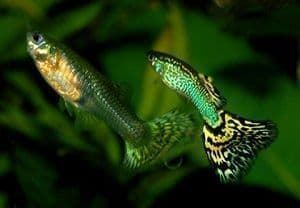
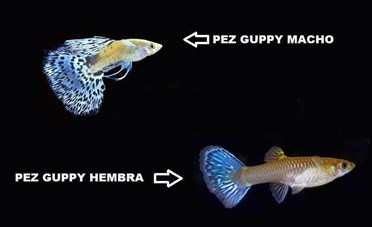
TO BE ABLE TO TAKE CARE OF THEM, YOU HAVE TO KNOW WHAT THEIR BEHAVIOR AND COMPATIBILITY IS:
Guppies are calm fish, although they should not be placed next to species that bite their fins, such as the Siamese Fighting Fish, which is very territorial and cannot tolerate fish as active as Guppies.
Among the fish compatible with Guppies, we can mention the Mollies and the Lemon Tetra and some other characins.
In the aquarium, the male usually harasses the females constantly, to avoid this type of overwhelming situation, it is recommended to have one male for every three females.
In the following list you will find fish that are fully compatible with Guppies, because they have a similar behavior and the parameters of the aquarium are similar, we could say that they meet three basic requirements:
- They have a similar size, although it is not always a guarantee of success.
- If they end up outgrowing the Guppies, there will come a time when they cannot share space, such as with Koi Carp or Goldfish.
- Depending on the nature of the fish itself.
- This is difficult to calibrate, but they could share space with fish that are theoretically aggressive, such as a male Betta, as long as the latter's character is not "too" aggressive.
Compatible fish without restrictions:
- Tiger Barb.
- Harlequin.
- Rasbora Galaxy.
- Corydoras.
- drunk.
- Ancistrus.
- Tetra Neon.
- Botia Clown.
- Ax Fish.
- Mollies.
- Boraras.
- Chinese neon.
- female betta.
- Nun.
- Silver Dollar.
- Kribensis.
- Apple Snail.
- Cherry Barbel.
- Otocinclus.
- Guppy Endler.
Fish compatible with restrictions:
- Ramirezi.
- Angel fish.
- Platy.
- Rainbow.
- Koi carp.
- Goldfish.
- Telescope.
- Disk.
- Wasp.
- Pearl Gourami.
THE BEST NUTRITION FOR YOUR GUPPY FISH IS:
Guppies are omnivorous animals and are not very selective when it comes to food, both in their natural environment and in the aquarium. Despite this, they do have their preferences and love to eat food that flies in, like mosquitoes.
Live feeding is ideal to supply them with all the important nutrients.
Sometimes guppies look for algae among stones and roots or nibble on soft plants.
Food is digested in as little as forty-five minutes, so they should be fed small amounts fairly frequently.
One day of fasting a week is good for the health of these fish, as this relieves the intestine and promotes the development of young animals.
The flakes are the main food source, as they are very easy to have on hand.
With a water content of 80 percent, they resemble natural food and contain the optimal nutrient composition.
You should know that once you have opened the container, the minerals and vitamins disintegrate quickly, so the content must be consumed within 3 months.
The flakes break down in water in forty-five minutes, while the granules remain whole for four hours. This makes many aquarists prefer granules.
Frozen food is also suitable for the aquarium, but must not exhibit any freezer burn.
Must be supplied frozen.
Live food is the closest thing to the natural diet of the species, but it is somewhat more expensive to acquire.
In their natural habitat, guppies hunt fry, marine insects, mosquitoes and insect larvae, spiders, and small animals that have fallen into the water such as snails and worms.
When feeding them in the aquarium, never give them more food than the fish can eat in five minutes.
The most delicate thing to keep guppies is feeding. They are omnivores, feeding on frozen food, flake or flake food, and freeze-dried food.
Among the most popular live or freeze-dried foods suitable for guppies are salted shrimp, daphnia and mosquito larvae.
Feed your guppies only once or twice a day in small amounts.
Although in the wild they basically feed on insects, especially red mosquito larvae, those raised in captivity admit a wide variety of foods.
Mosquito larvae cannot be missing from their diet, since they provide them with a large amount of protein, necessary for their growth.
The diet should contain daphnia, artemia, which must be supplemented with plant foods in the form of green algae.
There are also many dry foods on the market in the form of flakes, flakes or granules, which are usually very good, because they contain algae, crustaceans and other components that vary depending on the brand and the fish's diet.
A good diet has a direct influence on the coloration of the Guppies, so it is important to keep them healthy and well fed, as well as adding vitamins from group D from time to time.
It is recommended to feed them several times a day because they have a very fast metabolism.
They should be offered small amounts of food, just what they can devour quickly, this way we will avoid that part of this food ends up at the bottom of the aquarium, damaging the quality of the water.
At Glu Glu Pet we recommend the following products:
FOR YOUR GUPPY FISH TO REPRODUCE IN CAPTIVITY, FOLLOW THE FOLLOWING STEPS:
The Guppy is a fish that reproduces easily.
If we want to breed Guppies in our aquarium, the ideal is to have several females for each male, since they are quite vigorous in their search for females.
The reproduction of the Guppies is of the ovoviviparous type, this means that the female Guppy keeps the eggs inside her, until the time of delivery arrives.
The ritual dance of the male before mating is quite striking.
Once the female is receptive, the male copulates in a fiftieth of a second.
The female is fertilized with the spermatophores, which can be kept inside the female to be fertilized up to five times, without the need for the male to copulate again.
The gestation period will last about five weeks, and can lay between fifty and one hundred and fifty fry.
Guppies have an extraordinary reproductive capacity, so you will have to make a decision for them to coexist in your aquarium:
- If you do not intend to keep guppies in your tank, you should choose to keep males or females only (males are usually more colorful than females).
- If you decide to keep both sexes, so that the females do not get too stressed, the ratio of males to females should be one male for every three females.
Guppies reach sexual maturity at 3 months of age.
In females that are gestating, a black spot can be seen on the back, and as the spot becomes larger and darker, the moment of delivery approaches.
It is convenient to separate the fry to another tank after they are born to prevent them from being eaten, until they reach a size larger than the mouth of the fish with which they are going to share the aquarium.
A twenty-five liter aquarium is more than enough for a litter of twenty pups.
For large litters of more than sixty pups, an aquarium of at least eighty liters is necessary.
Guppies often eat their offspring, so it is recommended to have more females than males.
Guppies are social animals and live in groups, so you should have at least five of these popular fish in the same container.
Large aquariums with few animals are also not a problem, as the guppies quickly get used to a regular supply of food.
As in a large aquarium they move more, they develop more muscles.
They are also well suited to more confined environments, as long as the water is changed regularly.
Guppies reach sexual maturity at three months.
Larger aquariums are better suited for raising young guppies.
For the temporary accommodation of new fish, a quarantine aquarium is ideal, as there is always a risk of infection from old populations.
It is easier to control new inhabitants when the temporary tank is small.
The aquarium must have a cover that also protects the feeding area, since it is above all here that many animals accumulate and there is a risk that some will jump out because of the overwhelm.
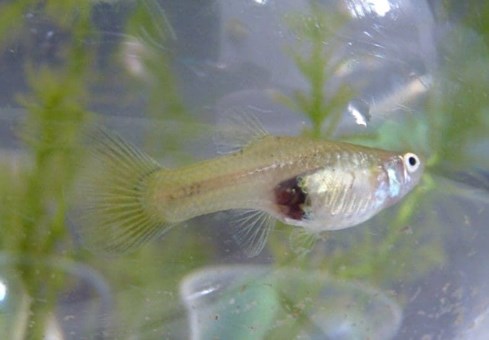
We will recognize a pregnant female Guppy, when we observe a dark area behind her anal fin, just behind the abdomen.
To have a high success rate, it is recommended to transfer the pregnant Guppy to a breeding tank, where the same water that we have in the tank should be used, so as not to alter the usual conditions.
An environment with many plants and floating vegetation favors the survival of the fry, which are often chased by their mothers to eat them.
In the first stages they should be fed with brine shrimp, crushed scales or powdered food.
At first the fry may seem disappointing, due to their lack of color. It is not worrying, about three months they are beginning to appreciate their colorful ending, although whether it appears earlier or later will be influenced by the diet and the use of vitamins.
THESE ARE THE BEST CONDITIONS OF THE AQUARIUM AND ITS MAINTENANCE;
The size of the aquarium must be in the 80 liters, 45x30x30.
The Guppy fish prefers hard water, although it can live in other more acidic or softer conditions, a good pH is between 7 and 8.5.
The temperature of the water must be between 22º and 28º.
Depending on the color of our Guppies, we can place substrates of different colors, to make them more attractive and showy.
As for aquarium plants, we all know that they are a component that helps us maintain the quality of the water, and therefore, the health of our fish.
To maintain good fish health, it is recommended to change 20% of the aquarium water once a week.
Guppies are known for their robustness and great ability to adapt to different environments, but if you really want your guppies to feel comfortable, there are a few things you can do to make your tank fit their exact needs.
The easiest way to do this is to mimic the atmosphere of their natural habitat in the waters of the Amazon River or in rivers and lakes throughout South America.
To achieve this similarity, your aquarium needs:
- Good vegetation.
- Free areas and floating plants to dim the light.
- The temperature of the aquarium should be between 18 to 28 ºC.
- The pH of the water should be between 7.0 and 8.0.
- And the GH (hardness) from 10 to 25 ºGH.
Guppies are very small fish, but they do need reasonable space and you will need to make sure their tank is large enough for them to swim comfortably, a minimum of 40 litres.
As for the number of guppies, it is recommended 1 guppy for every 5 liters.
The weak point of these fish is copper sulfate, a substance that is used to eliminate snails in the aquarium, this substance can cause serious problems for them, even death.
In an aquarium for guppies there must be aquatic plants. These stabilize coexistence and serve as a refuge. In addition, they produce substrate, which is a very important source of nutrients for young guppies. These water plants must be robust and tolerate irregular supplies of salt. Guppies swim throughout the aquarium, so each layer must have plants. Plant undergrowths at the bottom of the aquarium are used as a nighttime hiding place. Floating plants on the surface also use them to hide. Moss filters harmful substances from the water.
An excessive multiplication of plants is not convenient, as this means that very little light enters the enclosure.
There shouldn't be too much moss either, as it will influence the pH of the water.
These fish do not like the current and neither do those tank mates that are very active.
For permanent holding, the aquarium must be at least two feet long.
The products that we recommend from Glu Glu Pet for your guppy fish:
- 100L aqualed aquarium kit with Optimus filter (ICA).
- AQUALED 68 PRO(ICA) aquarium kit.
- Anubia Barteri var. potted lullaby
- Anubia Nana in pot.
- Cryptocoryne Undulatus Green.
- EHEIM CLASSIC 150 / 2211.
- EHEIM CLASSIC 250/2213.
- EHEIM CLASSIC 350/2215.
- EHEIM CLASSIC 600/2217.
- EHEIM PROFESSIONAL 4 250.
- EHEIM PROFESSIONAL 4 350.
- Fluval 207 External Filter.
- Fluval 307 External Filter.
- JBL Cristal professional e402.
- SEA-STAR THERMOHEATER 25W-300W.
- Tetratec HT heater.
- 25-300W Magicterm heaters (PRODAC).
- JAGER THERMOHEATERS 25W-300W(EHEIM).
- Thermometers.
- inert substrates.
- Fertilizer substrates.
- rocks.
- logs.
- Ornaments.
- Aerators and accessories.
- Conditioners.
- Anti-algae and fertilizers.
- Cleaning.
- Analysis test.
THE BEST CARE OF GUPPY FISH ARE THE FOLLOWING:
They are quite peaceful, although you have to be careful with their companions, as they tend to bite their large and colorful tails.
They are usually actively swimming throughout the aquarium. If a guppy is standing on the bottom of the tank it is a sign that it might be sick.
When they get used to feeding schedules, they will swim to the surface whenever they see you "begging" for food (they will beg even on a full stomach). This behavior means that they associate humans with food.
The guppy fish: easy to care for and ideal for children.
The guppy is one of the most popular freshwater aquarium fish in the world.
It reproduces without any problem, even in confinement, it is easy to care for and is therefore ideal for beginners in the aquarium hobby. It is a colorful fish that is not affected by small negligence.
These active little animals are seen in a wide variety of shapes and colors.
THE HEALTH OF GUPPY FISH:
Some species are prone to diseases such as velvet or white point.
Velvet disease is a fungus that attacks the gills, causing the fins to fray.
The most common cause is the infrequency with which the water is changed, which has to be cleaned and put in kitchen salt without iodine.
White spot disease is due to an infestation of parasites.
Those fish that are in good health can overcome this disease without needing treatment, which makes them immune to this parasite.
Affected animals do not need to be quarantined, as the water is also infested.
Parasites can be removed by UV irradiation with a UV water clarifier. As an alternative the fish can be treated by the administration of drugs.
Treatment lasts two to three weeks and must be administered as prescribed.
At Glu Glu Pet we recommend these treatments:
Since the guppy adapts easily, it can live with many other fish.
You will know if he is comfortable if he procreates soon.
The stronger the animal's immune system, the greater its protection against disease. You can achieve this by providing optimal living conditions.

